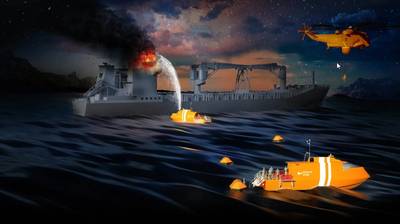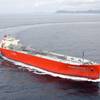Saab Develops Concept for Remotely Operated Rescue Craft
A new-generation rescue craft proposed by Saab’s Docksta Shipyard would use remote-operation technology to dramatically cut response times for maritime accidents.
Known as the Docksta Loitering, Optionally Crewed, High Speed Rescue Vessel (LHSRV), the proposed vessel could potentially travel at speeds in excess of 40 knots to maritime emergencies to provide a safe evacuation point for up to 20 survivors at a time.
One potential application for the craft is in the oceans around Canada, where accidents frequently occur in cold waters more than 100 nautical miles from shore.
The LHRSV has been developed in cooperation with John Dalziel and Ron Pelot from Dalhousie University, Halifax, Canada.
The starting point for the development of the LHSRV’s concept was understanding the limitations of current rescue resources for remote ocean emergencies. Under the International Convention for Safety of Life at Sea, national governments are required to operate and maintain search and rescue facilities within their designated rescue zones.
Crewed ships can be used for such rescues, but they are expensive to maintain on station, relatively slow and affected by heavy weather. Fixed wing aircraft have limited time on station and rescue capabilities, while helicopters have severe limits on their range, time on scene and survivor capacity.
The proposed features of the LHSRV would allow it to overcome many of these challenges, and to work in cooperation with conventional search and rescue platforms.
Measuring 20 meters, the concept vessel’s hull would be based on Saab’s successful Docksta 20 Interceptor craft, currently used in patrol. Constructed from aluminium, the LHSRV would feature a self-righting design to allow it to quickly recover from capsizes and to survive rough seas. A superstructure designed to minimize ice build-up would allow for operation in cold water environments, such as the North Atlantic.
Meanwhile, a substantial battery system capable of being recharged by both a generator and photovoltaic cells would enable the craft to remain on station in the remote ocean for periods of between five and 20 weeks, depending on conditions. The range for rescue missions would be up to 300 nautical miles on top of loitering time, with the vessel able to travel 200 nautical miles or more to reach its station.
The LHSRV would make use of autonomous and remote-operation technologies, some of which have been demonstrated Saab’s Enforcer III test craft. These would allow it to be controlled entirely remotely from a control room on land. With no crew on board, the craft could achieve speeds in high seas that no equivalent crewed vessel could manage.
Once at the scene of an accident or incident, remote communications features would allow it to act as a communication hub and to interact with the crew of stricken vessels. A remotely operated man-overboard system would allow it to retrieve survivors already in the water and receive evacuees from sinking vessels. The LHSRV could then potentially convey survivors to shore or stay on the scene until other resources arrive.
The interior of the vessel includes an emergency helmsman seat to allow one person to maneuver and pilot the vessel. A range of life-support compartments would provide space for those who have been rescued. These spaces feature soft, rounded edges to avoid evacuees being injured in high seas.
While the initial application proposed by the Docksta team is within Canadian waters, many other nations are regularly called on to perform rescues in remote parts of the ocean. The concept could be of use in the waters around New Zealand, Australia, Denmark, Iceland, and Norway’s Svalbard archipelago.
The next step in the development of the LHSRV would be the construction of a prototype.
“We presented the need, the shortage of maritime rescue resources in many parts of the world, focusing on the coast of Labrador, the incidents which take place, and a concept of a craft stationed 'nearby' which is able to proceed at high speed to provide a timely rescue response,” said Dalziel. “Saab, with its proven Docksta CB90 high speed vessel, and technical expertise provided a solution. Hopefully this partnership will continue into the future, and with search & rescue partners providing the operational expertise, we can make the world's oceans safer for all.”











